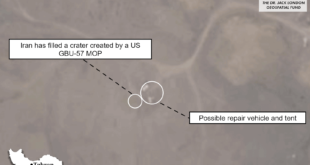India is one of the world’s largest armaments importers and continues to expand the scope and range of its defence and strategic cooperation with countries like the U.S., France, Israel, and Russia. In 2016, the U.S. recognised India as a “Major Defence Partner”, a title that consents on India buying more cutting-edge and sensitive technologies from the U.S. at par with America’s closest allies and partners and guarantees durable support in the future.
India’s growing strategic partnerships, particularly with the U.S., have had a noticeable impact on the South Asian regional security landscape, specifically in the realm of defence cooperation. The Indo-U.S. strategic partnership has raised concerns about the strategic stability and conventional balance in the South Asian region. Unfortunately, the U.S. is choosing to ignore the delicate security dynamics of South Asia. This region has been consistently impacted by the consequences of Western arms trade with India. Evidently, the so-called civilized West knows that, unlike other regions, South Asia is unstable and home to territorial conflicts between two nuclear-armed adversaries.
For decades, Russia remained the major supplier of arms to India with 65% share only a few years ago. That has now come down to 45% while the U.S. share has jumped from 1% to 11 %. Recently, Indian Prime Minister Narendra Modi’s state visit to the U.S. in late June is a clear reminder of the thriving strategic partnership between India and the United States. The warm reception by the Biden administration and the special honour of addressing a joint session of the U.S. Congress underscored their strong dedication to taking the Indo-U.S. relationship to new heights. Prime Minister Modi’s visit was not only filled with symbolic gestures, but it also resulted in significant and meaningful agreements, including the recent U.S.-India initiative on Critical and Emerging Technology, which seeks to foster bilateral collaboration on technologies such as artificial intelligence, biotechnology, quantum computing, 5G, and cybersecurity. The U.S. semiconductor manufacturer Micron Technology announced that it plans to invest $825 million in a new chip assembly and testing facility in India. The U.S. and India have unveiled several defence agreements, including a deal for India to acquire 31 MQ-9B Predator armed drones from the U.S. and a separate plan to produce F414 fighter jet engines for the Indian Air Force jointly with General Electric. Furthermore, the U.S. and India agreed upon certain clauses of the Basic Exchange and Cooperation Agreement (BECA) agreement, which was already signed in 2020.
The U.S. views India as a crucial ally in South Asia to counterbalance the growing influence of China. A compelling demonstration of this is signing of four foundational agreements between the two countries in past years, which will bolster interoperability, intelligence sharing and exchange of geospatial information between their militaries. These include General Security of Military Information Agreement (GSOMIA), Logistics Exchange Memorandum of Agreement (LEMOA), Communications Compatibility and Security Agreement (COMCASA), and the Basic Exchange and Cooperation Agreement (BECA). The U.S. wants to strengthen its allies in the South China Sea (SCS) as it alone cannot keep a check on Chinese developments. India is seen as a vital player to counter China not only in South Asia but also in other parts of the world including SCS for which it has been made part of the QUAD (U.S., Australia, Japan, and India). Such developments have direct implications for Pakistan and are certainly leading to strategic instability in the South Asian region.
India is likely to be a U.S. outpost in South Asia, like Israel in the Middle East. Growing Indian stature would influence America’s decision-making especially regarding South Asia. How China and India are going to interact in future is still uncertain. What is certain is that India will not play its game against China the way U.S. thinks. With an ever-increasing trade figure of India with China, India will prove to be an unreliable U.S. ally. The U.S. cooperation with India in multiple domains of defence may be driven by the profitable Indian markets, but its regional consequences will be calamitous in the long run. With American support, India won’t be reluctant to experiment with its military doctrines and policies in the region, particularly against Pakistan.
South Asia is one of the most complex, volatile, and fragile regions of the world. Strategic communities around the world are unanimous in their views that Indo-Pak conflict can trigger a nuclear exchange. The Indo-Pak historical enmity is further widening due to India’s unwillingness to engage with Pakistan in a meaningful dialogue. In such circumstances, massive inflow of deadly weapons to India, without caring for regional sensitivities is further adding to instability.
Pakistan is likely to be marginalized with reduced footprint in security calculus of United States. In response to such a threatening environment, Pakistan must make corrections that will assist it to restore balance of power in the region and decrease negative consequences of the Indo-U.S. strategic relationships and civil nuclear collaboration.
Pakistan should capitalize on its cooperation with China in the nuclear energy field. This collaboration would fulfil Pakistan’s energy needs and further boost its bilateral ties with China. It needs to diversify its relations with Iran on equality bases as mutual respect and cooperation with Iran would help Pakistan to solve its energy crisis. Pakistan should continue to build its ties with the U.S. on issues of common interests including cooperative arrangements on climate change, trade, non-proliferation of weapons of mass destruction, narcotics control and international terrorism.
Pakistan is in a paradox; it will have to retain an intricate balance in pursuing its ties with U.S. vis a vis China. Only economically and militarily strong Pakistan can deal with the negative consequences of Indo-U.S. alliance. Strategic stability in South Asia rests on balance of power. And as the history bears testimony that in the face of India’s belligerence, the onus for maintaining and restoring strategic stability in South Asia rests with Pakistan.
 Eurasia Press & News
Eurasia Press & News




